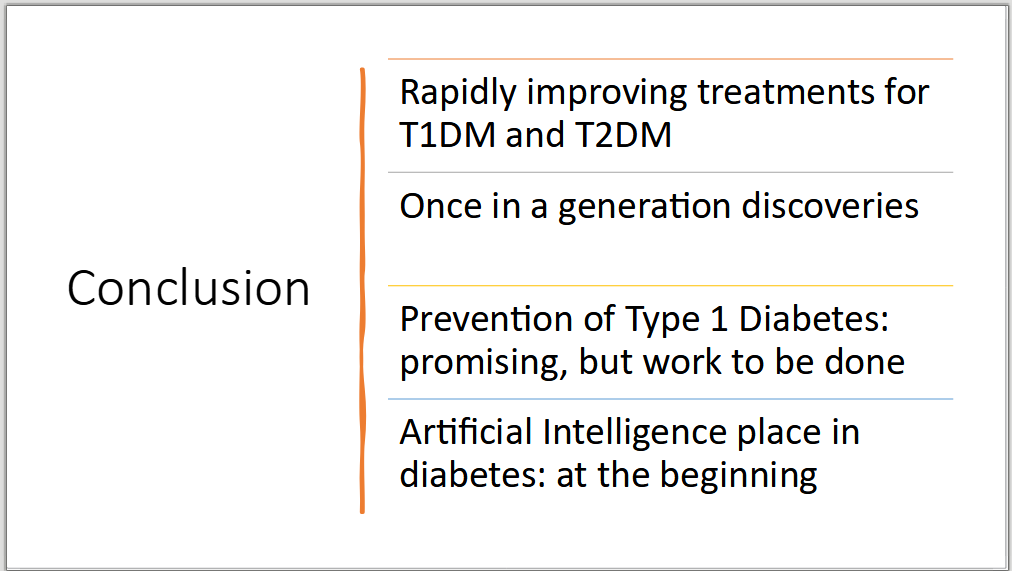
Dr Shane Hamblin, Head of Endocrinology & Diabetes, Western Health, Endocrinologist at The Alfred and PhD student in School of Public Health and Preventive Medicine at Monash University. President Elect of the Endocrine Society of Australia.
Given 20 minutes to summarise the latest scientific findings to an overcrowded room of world-class diabetes experts, curious non-experts and conference attendees looking to fill time between other talks, Dr Shane Hamblin’s presentation at the ESA’s Annual Scientific Meeting wowed the crowd with new tech, new drugs, and surprising research.
We have the technology
Insulin Pumps and Continuous Glucose Monitors are established technology, replacing uncomfortable fingerprick tests and insulin injections. The hardware of these devices hasn’t changed much in the past few years but the software has, becoming more adaptive and sensitive to changes in glucose and insulin.
After eating, glucose doesn’t teleport to every cell instantly – it’s transferred into the blood from the intestines and absorbed by different body parts with the help of insulin as the gatekeeper.
As Continuous Glucose Monitors measure glucose levels in the interstitial fluid between cells under the skin, their estimate is about 10 to 15 minutes behind the actual blood glucose level. Because of this, low glucose alarms are set a bit higher than the actual danger point, to account for this time delay.
Newer insulin pump algorithms also monitor the rate of change, and can sound an alarm when glucose levels drop too fast, even if they’re still within the normal range. The pump is always playing catch-up in response to glucose events, but they’re getting much better at catching.
One advance in hardware makes monitoring even more convenient – Continuous Glucose Monitor sensors usually need to be changed every week or so, but a new version under development promises up to 6 months of use.
Adjusting the insulin levels of a sick hospital patient is one of the more complicated tasks an endocrinologist can perform. However, this job usually falls to overworked junior doctors. A study of an machine learning assistant developed to recommend insulin adjustments for a complex patient showed a surprising result – the assistant performed better than the junior doctors, and slightly better than a registrar, though not as well as a consultant. This technology could free up junior doctors for other tasks, and maybe even reduce their workloads.
Highlighting one of the potential downsides of new tech, the slideshow for this section of the presentation failed, reverting to the starting slide. While a fun distraction during a conference, the consequences for an AI or algorithm going on the blink are much more serious.
As such, Shane stressed the need to keep doctors and patients skilled in diabetes management, likening them to a human pilot’s role when flying. An autopilot can usually keep a plane steady, but oversight by a human expert is always necessary to monitor its performance, handle the tricky bits, and take over in case of an emergency.
While new algorithms and AI make everyday life easier, it’s important that reliance on their capabilities doesn’t result in doctors and patients losing their own skills. Technology is a good wingman, and becoming even better as software improves, but patients and doctors must remain in the driver’s seat.
GLP-1 Agonists
Ozempic, Mounjaro and Wegovy have been described as miracle drugs, wonderdrugs, and the future of diabetes management. While these drugs work well for the people taking them, their high cost and off-label use for weight-loss prompt questions about health economics and the best place to invest national resources.
As an endocrinologist concerned with individual quality of life, Shane would love to see hot and cold running GLP-1 agonists on tap to every household. However, as a member of the Pharmaceutical Benefits Advisory Committee, and a PhD Candidate in Monash’s School of Public Health and Preventive Medicine, he is concerned at these medications being seen as a quick fix to systemic problems.
If these new drugs were added to the PBS for everyone with obesity it could use a quarter of its whole budget – but apples today could keep doctors away forever. (Naturally, the views expressed above are Shane’s own and not on behalf of PBAC.)
Western lifestyles have changed, becoming increasingly defined by casual work, shift work, car travel, convenience food, sitting, a changing climate, and plastics. How an average Australian works, what they eat, and what they get up to in their free time is very different to what it was 50 years ago. The lives of rural, remote and First Nations peoples have changed even more dramatically.
Our world has become more obesogenic – we live in circumstances that makes it easy to gain weight and difficult to lose weight.
While GLP-1 agonists are understandably and justifiably popular, their success might obscure more practical preventative measures to address the reasons diabetes and obesity are increasing.
Preventing Type 1 Diabetes
Far from a typo, Associate Professor John Wentworth of the Walter and Eliza Hall Institute of Medical Research has been working towards the early detection and prevention of Type 1 Diabetes for over 20 years.
Type 1 Diabetes is often thought to be a childhood disease, but it can also appear in older people. When it does, it’s usually after years of pancreatic trauma perpetrated by misguided immune cells. By the time people feel the effects of this damage it’s too late to save the organ, and patients have to manually perform the role of their own pancreas for the rest of their lives.
Relatives of people with Type 1 Diabetes have a higher risk of developing it themselves. Associate Professor Wentworth’s team have developed an at-home test that identifies the presence of hostile immune antibodies before symptoms even start to show.
If found early enough, treatment with immune drugs like Baricitinib might be able to delay the onset of diabetes, though not halt it entirely. The research is ongoing – and can always do with more funding.

Concluding slide from Dr Shane Hamblin’s presentation.
Shane’s Pretty hot Diabetes (PhD) research
Shane’s research looks at the past ten years of PBS data to investigate how diabetes drugs are used in Australia.
Have there been changes in prescribing habits over the past decade? Are patients in different areas prescribed different medications? How long do patients try one drug before they’re prescribed another? Are drugs ever de-prescribed, or are patients just given more drugs to take on top of existing ones? Do doctors update their prescribing practices, and how quickly?
In a few years these questions won’t just be speculative, but answered by Shane Hamblin’s research.
Currently, the PBS and the Australian Diabetes Society offer differing guidelines for the prescribing of diabetes medication. Shane hopes his research will drive change, highlight new areas of study, and help doctors practice rational prescribing.







